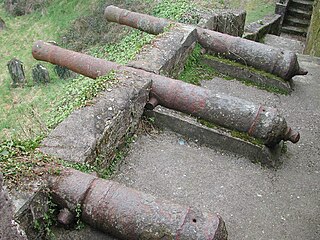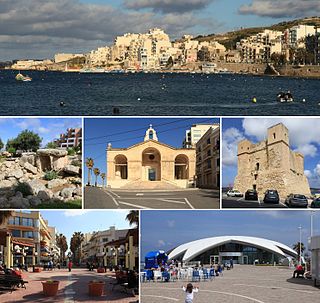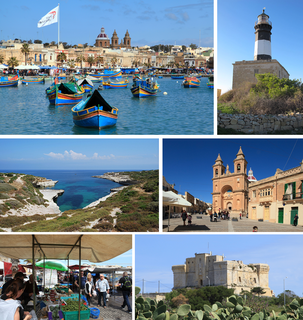| Malta Coast Artillery | |
|---|---|
| Active | 1802–1815 |
| Country | |
| Branch | |
| Role | Coastal artillery |
| Size | Three companies |
| Garrison/HQ | St. Paul's Bay and Marsa Scirocco |
| Commanders | |
| Captain | John Vivion |
The Malta Coast Artillery was a coastal artillery unit in the British Army which existed from 1802 to 1815 in Malta, then a British protectorate and later a colony.

Coastal artillery is the branch of the armed forces concerned with operating anti-ship artillery or fixed gun batteries in coastal fortifications.

The British Army is the principal land warfare force of the United Kingdom, a part of British Armed Forces. As of 2018, the British Army comprises just over 81,500 trained regular (full-time) personnel and just over 27,000 trained reserve (part-time) personnel.

Malta, officially known as the Republic of Malta, is a Southern European island country consisting of an archipelago in the Mediterranean Sea. It lies 80 km (50 mi) south of Italy, 284 km (176 mi) east of Tunisia, and 333 km (207 mi) north of Libya. With a population of about 475,000 over an area of 316 km2 (122 sq mi), Malta is the world's tenth smallest and fifth most densely populated country. Its capital is Valletta, which is the smallest national capital in the European Union by area at 0.8 km.2 The official languages are Maltese and English, with Maltese officially recognised as the national language and the only Semitic language in the European Union.
According to the Treaty of Amiens of 1802, Britain was to evacuate Malta and restore the islands to the Order of St. John. The treaty also stated that at least half of Malta's garrison had to consist of 2000 Maltese soldiers led by native officers. Although the treaty was not implemented and the British did not evacuate Malta, the garrisons were readjusted, with the existing Maltese Light Infantry, Maltese Militia and Maltese Militia Coast Artillery being disbanded. [1]

The Treaty of Amiens temporarily ended hostilities between France and the United Kingdom during the French Revolutionary Wars. It was signed in the city of Amiens on 25 March 1802 by Joseph Bonaparte and Marquess Cornwallis as a "Definitive Treaty of Peace." The consequent peace lasted only one year and was the only period of general peace in Europe between 1793 and 1814.

Malta was ruled by the Order of Saint John as a vassal state of the Kingdom of Sicily from 1530 to 1798. The islands of Malta and Gozo, as well as the city of Tripoli in modern Libya, were granted to the Order by Spanish Emperor Charles V in 1530, following the loss of Rhodes. The Ottoman Empire managed to capture Tripoli from the Order in 1551, but an attempt to take Malta in 1565 failed.
The Maltese Light Infantry was a light infantry battalion of the British Army which existed from 1800 to 1802 in Malta, then a British protectorate. It consisted of eight companies of Maltese soldiers, and it saw action in the French Revolutionary Wars. It was the second Maltese unit in British service, after the Maltese Cannoneers.
The Malta Coast Artillery was set up in accordance with the treaty in 1802, taking over the role of the Maltese Militia Coast Artillery which had been set up in 1801. [1] The unit manned the batteries located at St. Paul's Bay and Marsa Scirocco, while detachments manned the coastal towers. Their duties included anti-smuggling operations. [2] In February 1803, the Malta Coast Artillery consisted of 170 men. By 1804, this had increased to three companies of 100 men each, raised to 150 men in 1806. [3] The unit was commanded by Captain John Vivion of the Royal Artillery, who had set up the Maltese Militia Coast Artillery.

In military organizations, an artillery battery is a unit of artillery, mortars, rocket artillery, multiple rocket launchers, surface to surface missiles, ballistic missiles, cruise missiles etc., so grouped to facilitate better battlefield communication and command and control, as well as to provide dispersion for its constituent gunnery crews and their systems. The term is also used in a naval context to describe groups of guns on warships.

Saint Paul's Bay is a town in the Northern Region of Malta, sixteen kilometres northwest of the capital Valletta. Saint Paul's Bay is the largest town in the Northern Region and the seat of the Northern Regional Committee along with being the most populous town in Malta.

Marsaxlokk is a small, traditional fishing village in the South Eastern Region of Malta. It has a harbour, and is a tourist attraction notable for its picturesque views, its fishermen and history. As at March 2014, the village had a population of 3,534. The village is also known for the Marsaxlokk Market, which is mainly a large fish market which takes place along the seafront on Sundays, and a tourist market during all other days of the week. Inhabited and well-known since antiquity, Marsaxlokk was used as a port by Phoenicians, Carthaginians and also has the remains of a Roman-era harbour. Originally a part of the city of Żejtun, the fishing village became a separate parish in the late nineteenth century.
Men from the Malta Coast Artillery wore the same uniform as that of the Royal Artillery, consisting of dark blue coats with red facings. [2]
The Malta Coast Artillery was amalgamated with the Maltese Provincial Battalions and the Maltese Veterans to form the Royal Malta Fencible Regiment on 16 February 1815. [3]
The Maltese Provincial Battalions were infantry battalions in the British Army which existed from 1802 to 1815 in Malta, then a British protectorate and later a colony.
The Maltese Veterans, also known as the Corps of Veterans, was a corps in the British Army which existed from 1803 to 1815 in Malta, then a British protectorate and later a colony.







